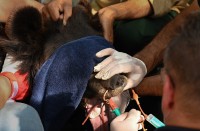 What is Animal Cruelty?
What is Animal Cruelty?
Cruelty to animals, also called animal abuse or animal neglect, is the human infliction of suffering or harm upon animals, for purposes other than self-defense or survival. More narrowly, it can be the causing of harm or suffering for specific gain, such as killing animals for food or for their fur; opinions differ about the extent of cruelty associated with a given method of slaughter. Cruelty to animals sometimes encompasses inflicting harm or suffering for personal amusement, as in zoosadism. Laws concerning animal cruelty are designed to prevent needless cruelty. Divergent approaches to such laws occur in different jurisdictions throughout the world.
Facts about animals
- It is believed that between nine to ten million animals inhabit the earth. They range in size from just a few small cells to many tons.
- All animals are heterotrophic. This means that they depend on other living organisms for their food.
- Most animals ingest food and then digest it in an internal cavity such as the stomach.
- Animals are grouped into two main categories. They are those with back bones (vertebrates) and those without (invertebrates).
Animal Welfare Organization
The American Society for the Prevention of Cruelty to Animals (ASPCA) is a non-profit organization dedicated to preventing cruelty towards animals. Based in New York City since its inception in 1866, the organization’s mission is “to provide effective means for the prevention of cruelty to animals throughout the United States.”
The Philippine Animal Welfare Society (PAWS) is a volunteer-based non-government organization whose goal is to prevent animal cruelty through education, animal sheltering and advocacy. PAWS believes that the creation of a more peaceful society starts with the widening of mankind’s circle of compassion which includes animals, thereby envisions a nation that respects animals, practices responsible pet ownership and protects wildlife.
 Laws that Protect Animals in Cruelty
Laws that Protect Animals in Cruelty
Republic Act No. 8485
“The Animal Welfare Act of 1998”
An act to promote animal welfare in the Philippines, otherwise known as “The Animal Welfare Act of 1998”
25 Amazing Facts You Didn’t Know About Animals
Be surprised by these 25 amazing facts about animals. Embrace yourself and be astounded with these magnificent creatures. Find out their capabilities and sheer brilliance.
- Housefly – Houseflies don’t allow their short life spans (14 days) to hinder their musical abilities. They always hum in the key of F.
- Ostrich – Ostriches can run faster than horses, and the male ostriches can roar like lions.
- Bat – Bats are the only mammals that can fly, but wouldn’t it be awesome if humans could fly too?
- Kangaroo – Kangaroos use their tails for balance, so if you lift a kangaroo’s tail off the ground, it can’t hop.
- Spider – On average, there are 50,000 spiders per acre in green areas. Bet you’ll think twice before going outside now – unless you’re this guy.
- Tigers – Tigers not only have stripes on their fur, they also have them on their skin. No two tigers ever have the same stripes.
- Crocodile – Here’s a tidbit that might be useful if you plan on becoming the next Steve Irwin: To escape the grip of a crocodile’s jaw, push your thumb into its eyeball – It will let you go instantly.
- Flea – Fleas can jump up to 200 times their height. This is equivalent to a man jumping the Empire State Building in New York.
- Cat – A cat has 32 muscles in each ear. Better for them to eavesdrop on your conversations and plot your demise.
- Elephant – Elephants can smell water up to 3 miles away. They are also one of the three mammals that undergo menopause – the other two being humpback whales and human females.
- Koala – Koala bears almost exclusively eat only eucalyptus leaves and nothing else.
- Beaver- Because beavers’ teeth never stop growing, they must constantly gnaw on objects to keep them at a manageable length. Their teeth would eventually grow into their brain if they didn’t maintain them.
- Ant – Beware an ant uprising! There are one million ants for every human in the world. These resilient creatures also never sleep and do not have lungs.
- Oyster – Oysters can change gender depending on which is best for mating. Talk about successful adaptation.
- Butterfly – Butterflies have two compound eyes consisting of thousands of lenses, yet they can only see the colors red, green and yellow.
- Snail – Don’t try this at home, but a snail can grow back a new eye if it loses one.
- Turtle – You can tell a turtle’s gender by the noise it makes. Males grunt and females hiss.
- Giraffe – Giraffes have no vocal cords and their tongues are blue-black in color.
- Squirrel – You might want to thank a squirrel the next time you enjoy the shade of a tree. Millions of trees are accidentally planted by squirrels that bury nuts and then forget where they hid them.
- Humpback whale – Humpback whales create the loudest sound of any living creature. And you thought the loudest sound came from that two-year-old you sat next to on your trans-continental flight, didn’t you?
- Dog – Dogs’ nose prints are as unique as human fingerprints and can be used to identify them.
- Seahorse – The slowest fish is the seahorse, which moves along at about 0.01 mph.
- Pig – Pigs communicate constantly with one another; more than 20 vocalizations have been identified that pigs use in different situations, from wooing mates to saying, “I’m hungry!”
- Poodle – Contrary to popular belief, french poodles actually originated in Germany. Maybe you should’ve named her Gretl instead of Fifi.
- Hummingbirds – Hummingbirds are the only birds that can fly backwards and their wings can beat at up to 80 times per second.
References:
http://list25.com/25-amazing-facts-you-didnt-know-about-animals/5/
http://www.teach-nology.com/monthly/april/aprilevents.html







